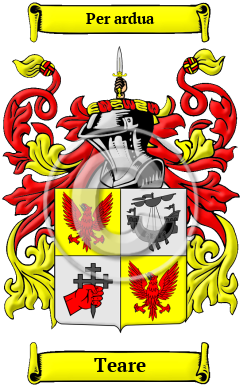| ![Show Contents]() Teare History, Family Crest & Coats of Arms Teare History, Family Crest & Coats of Arms
- Origins Available:
Scotland
Ireland Etymology of TeareWhat does the name Teare mean? The age-old Hebrides islands and the west coast of Scotland are the ancestral home of the Teare family. Their name comes from the Gaelic form Mac-an-Tsaoir, which denotes son of the carpenter or wright. Early Origins of the Teare familyThe surname Teare was first found in on the Isle of Iona, where they held a family seat from early times and their first records appeared on the early census rolls taken by the early Kings of Britain to determine the rate of taxation of their subjects. Early History of the Teare familyThis web page shows only a small excerpt of our Teare research. Another 64 words (5 lines of text) covering the years 1372, 1564 and 1890 are included under the topic Early Teare History in all our PDF Extended History products and printed products wherever possible. Teare Spelling VariationsMedieval spelling was at best an intuitive process, and translation between Gaelic and English was no more effective. These factors caused an enormous number of spelling variations in Dalriadan names. In fact, it was not uncommon to see a father and son who spelled their name differently. Over the years, Teare has been spelled MacAteer, MacTear, MacTeir, MacTire, MacAtee, MacAtter, MacAttur and many more. Early Notables of the Teare familyMore information is included under the topic Early Teare Notables in all our PDF Extended History products and printed products wherever possible. Migration of the Teare family to IrelandSome of the Teare family moved to Ireland, but this topic is not covered in this excerpt.
Another 80 words (6 lines of text) about their life in Ireland is included in all our PDF Extended History products and printed products wherever possible.
| Teare migration to the United States | + |
Scottish settlers arrived in many of the communities that became the backbones of the United States and Canada. Many stayed, but some headed west for the endless open country of the prairies. In the American War of Independence, many Scots who remained loyal to England re-settled in Canada as United Empire Loyalists. Scots across North America were able to recover much of their lost heritage in the 20th century as Clan societies and highland games sprang up across North America. Early immigration and passenger lists have documented some of the first Teares to arrive on North American shores:
Teare Settlers in United States in the 17th Century- Reynold Teare, who arrived in Maryland in 1668 1
| Contemporary Notables of the name Teare (post 1700) | + |
- Richard W. Teare (b. 1937), American politician, U.S. Ambassador to Papua New Guinea, 1993-96; Solomon Islands, 1993-96; Vanuatu, 1993-96
- Phillip Teare, American politician, Member of California State Assembly 15th District, 1863-65; U.S. Attorney for the Northern District of California, 1878-83
- Paul L. Teare, American Republican politician, Candidate for West Virginia State House of Delegates from Ohio County, 1964
- L. L. Teare, American Democratic Party politician, Delegate to Democratic National Convention from Missouri, 1912
- John Teare (1850-1936), American Republican politician, Chair of Roberts County Republican Party, 1898-99; Member of South Dakota State House of Representatives 33rd District, 1903-04
- Mr. Melvyn Roy Teare M.B.E., British recipient of Member of the Order of the British Empire on 8th June 2018, for services to the community and to local charities in St Albans 2
The motto was originally a war cry or slogan. Mottoes first began to be shown with arms in the 14th and 15th centuries, but were not in general use until the 17th century. Thus the oldest coats of arms generally do not include a motto. Mottoes seldom form part of the grant of arms: Under most heraldic authorities, a motto is an optional component of the coat of arms, and can be added to or changed at will; many families have chosen not to display a motto.
Motto: Per ardua
Motto Translation: Through difficulties.
- Filby, P. William, Meyer, Mary K., Passenger and immigration lists index : a guide to published arrival records of about 500,000 passengers who came to the United States and Canada in the seventeenth, eighteenth, and nineteenth centuries. 1982-1985 Cumulated Supplements in Four Volumes Detroit, Mich. : Gale Research Co., 1985, Print (ISBN 0-8103-1795-8)
- "Birthday and New Year Honours Lists (1940 to 2019)." Issue 62310, 4 July 2019 | London Gazette, The Gazette, June 2018, https://www.thegazette.co.uk/London/issue/62310/supplement/B1
 |

